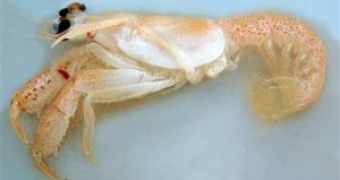Into the Deep Sea, there live creatures more mysterious than many could have imagined. At one site, nearly 2 miles deep in the Atlantic, shrimp were living around a vent that was releasing water heated to 765 degrees Fahrenheit. Water surrounding the site was chilly - 36 degrees.
An underwater peak in the Coral Sea was home to a type of shrimp thought to have gone extinct 50 million years ago. More than 3 miles (5 km) beneath the Sargasso Sea, in the Atlantic, researchers collected a dozen new species eating each other or living on organic material that drifts down from above. "Animals seem to have found a way to make a living just about everywhere," said Jesse Ausubel of the Sloan Foundation. Ron O'Dor, a senior scientist said: "We can't find anyplace where we can't find anything new."
This year census of marine fauna is part of a study of life in the oceans that is scheduled for final publication in 2010 and supported by governments, United Nations and private conservation organizations. About 2,000 researchers from 80 countries are participating.
There are nearly 16,000 known species of marine fish, from which a couple of thousand have been discovered during the census. 19 ocean expeditions were conducted this year; a 20th is still on course in the Antarctic. 128 nearshore sampling sites were operated and using satellites, followed more than 20 tagged species including sharks, squid, sea lions and albatross.
Among the interesting founds of 2006 there are:
- Shrimp and clams living near the super-hot thermal vent in the Atlantic, where they confront pulses boiling water while spending the time into the frigid deep sea.
- around the Antarctic, marine life shrouded in darkness beneath more than 1,600 feet (500 m) of ice. Sampling of this remote ocean yielded more new species than the already-known ones. Off the coast of New Jersey, 20 million fish are swarming in a shole the size of Manhattan.
- in the Coral Sea, a shrimp called Neoglyphea neocaledonica (photo), thought disappeared millions of years ago. Researchers dubbed it "the Jurassic shrimp".
- Satellite tracking of tagged sooty shearwaters, small birds, revealed the bird's 43,500-mile (70,000 km) search for food over the Pacific Ocean, from New Zealand via Polynesia to foraging grounds in Japan, Alaska and California and then back, with an average 217 (350 km) miles daily. Sometimes, a breeding pair made the entire journey together.
- A new find, a 4-pound rock lobster discovered off Madagascar.
- A single-cell creature big enough to be visible, in the Nazare Canyon off Portugal, at 14,000 feet (4700 m) deep. It is wrapped within a plate-like shell, 6 mm in diameter, composed of mineral grains.
- A new type of crab covered in "fur", near Easter Island. This unique species got a whole new family designation, Kiwaidae, named for Kiwa, the Polynesian goddess of shellfish.

 14 DAY TRIAL //
14 DAY TRIAL //